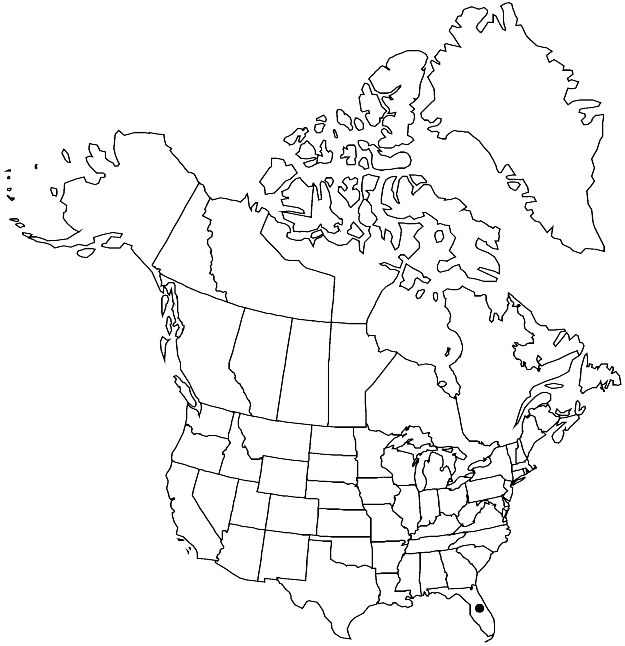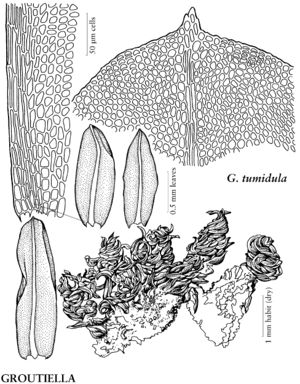Difference between revisions of "Groutiella tumidula"
Bryologist 82: 9. 1979.
FNA>Volume Importer |
imported>Volume Importer |
||
| (6 intermediate revisions by 2 users not shown) | |||
| Line 9: | Line 9: | ||
|special_status={{Treatment/ID/Special_status | |special_status={{Treatment/ID/Special_status | ||
|code=F | |code=F | ||
| − | |label= | + | |label=Illustrated |
}} | }} | ||
| − | |basionyms={{Treatment/ID/ | + | |basionyms={{Treatment/ID/Basionym |
|name=Macromitrium tumidulum | |name=Macromitrium tumidulum | ||
|authority=Mitten | |authority=Mitten | ||
| + | |rank=species | ||
| + | |publication_title=J. Linn. Soc., Bot. | ||
| + | |publication_place=12: 201. 1869 | ||
}} | }} | ||
|synonyms= | |synonyms= | ||
| Line 29: | Line 32: | ||
|elevation=low elevations | |elevation=low elevations | ||
|distribution=Fla.;Mexico;West Indies;Central America;South America. | |distribution=Fla.;Mexico;West Indies;Central America;South America. | ||
| − | |discussion=<p>Groutiella tumidula is distinguished by non-rugose leaves with a length-width ratio of less than 5:1, and by erect branches less than 5 mm high. The apex of the leaf is mucronate and never strongly apiculate, and the leaves are broadly longitudinally plicate when moist.</p> | + | |discussion=<p><i>Groutiella tumidula</i> is distinguished by non-rugose leaves with a length-width ratio of less than 5:1, and by erect branches less than 5 mm high. The apex of the leaf is mucronate and never strongly apiculate, and the leaves are broadly longitudinally plicate when moist.</p> |
|tables= | |tables= | ||
|references= | |references= | ||
| Line 38: | Line 41: | ||
-->{{#Taxon: | -->{{#Taxon: | ||
name=Groutiella tumidula | name=Groutiella tumidula | ||
| − | |||
|authority=(Mitten) Vitt | |authority=(Mitten) Vitt | ||
|rank=species | |rank=species | ||
| Line 51: | Line 53: | ||
|publication title=Bryologist | |publication title=Bryologist | ||
|publication year=1979 | |publication year=1979 | ||
| − | |special status= | + | |special status=Illustrated |
| − | |source xml=https:// | + | |source xml=https://bitbucket.org/aafc-mbb/fna-data-curation/src/2e0870ddd59836b60bcf96646a41e87ea5a5943a/coarse_grained_fna_xml/V28/V28_50.xml |
|genus=Groutiella | |genus=Groutiella | ||
|species=Groutiella tumidula | |species=Groutiella tumidula | ||
Latest revision as of 22:36, 5 November 2020
Plants reddish brown. Branch leaves with distal leaves widest mid leaf or distally, oblong to oblong-lingulate, 1–1.8 mm; margins entire; apex rounded-obtuse, mucronate, not fragile; costa prominent, ending just below or in mucro; distal laminal cells rounded-hexagonal, 6–9 µm. Sexual condition pseudautoicous, dwarf male plants on leaves and tomentum. Seta 3–5 mm. Capsule oblong to oblong-ovate, 1–1.5 mm. Spores anisosporous, 15–22 µm.
Habitat: Rock, trees, horizontal branches 1-3 m high
Elevation: low elevations
Distribution

Fla., Mexico, West Indies, Central America, South America.
Discussion
Groutiella tumidula is distinguished by non-rugose leaves with a length-width ratio of less than 5:1, and by erect branches less than 5 mm high. The apex of the leaf is mucronate and never strongly apiculate, and the leaves are broadly longitudinally plicate when moist.
Selected References
None.
